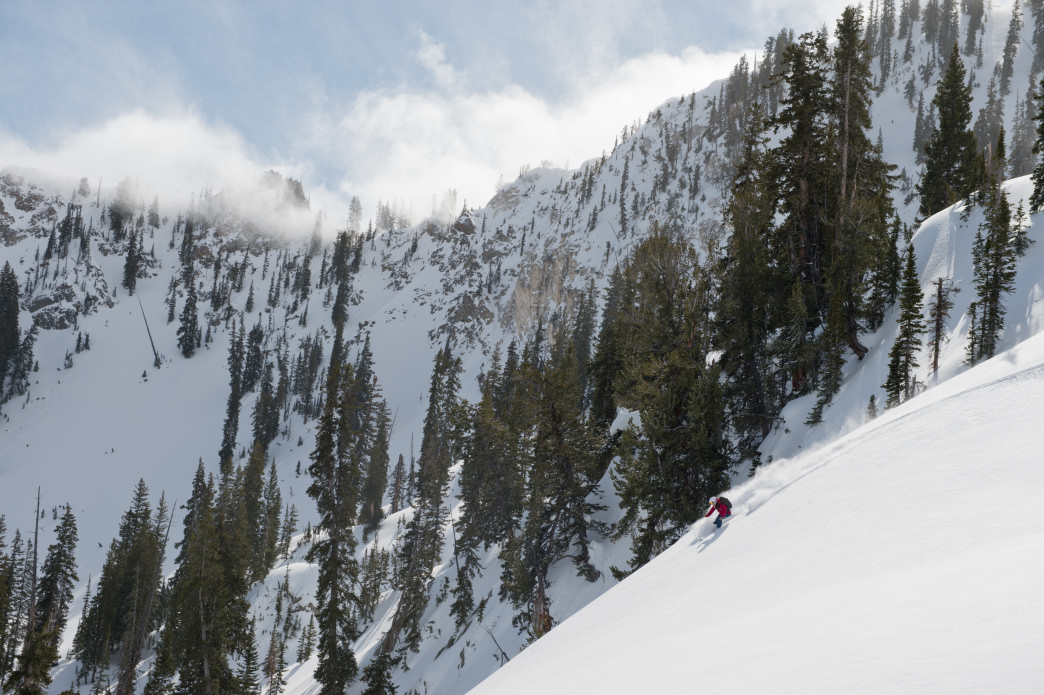Ski resorts are playgrounds for outdoor recreation, with clean air, healthy forests, wildlife, scenic views and an invigorating mountain environment. Traditionally, ski areas were not always eco-friendly, with bulldozers carving up fragile slopes, old-growth forests logged for ski runs, impacts on endangered wildlife, degraded water quality, and land damaged by infrastructure, condos, and parking lots. That negative development at the cost of the environment is changing thanks to a new awareness and eco-ethic fostered by resorts like Alta Ski Area, which recognizes that a healthy environment is essential for area sustainability and survival.
Alta Ski Area, tucked high in Little Cottonwood Canyon southeast of Salt Lake City, knows that its sustainability and future success lies in addressing the challenges posed by global warming, the changing climate, and increased use. Alta is committed to respecting its environment, working to reduce and recycle waste products, conserving energy, and preserving precious land and resources with partners in the greater Salt Lake City community. Alta Ski Area, which straddles both private and national forest-permitted land, has partnered with the town of Alta at its base and the U.S. Forest Service to maintain the mostly pristine area.
In 2008, Alta’s move to sustainability led to the creation of the Alta Environmental Center (AEC), which focuses on making the ski area a better steward of its lands. The center adopted a mission of sustainability and to "protect and improve the well-being of Alta’s environment, ski industry, and community."

Photo courtesy of Alta
The center defines Alta’s sustainability through three interlocking hubs—environment, economic, and social—which reflect the interconnectedness of each within the Alta system. Each of those hubs has three priority areas that guide the area’s future strategies, decision-making processes, and management practices.
The environment hub defines air quality, water supply and quality, and forest health measured by wildlife and vegetation. The economic hub views the cost efficiencies of operations, the future viability of the company, and the vitality of its community. The social hub considers the well-being and productivity of employees, the loyalty of its ski-users, and works on common goals with the Salt Lake community and industry.
The Alta Environmental Center works with Alta Ski Area and its various departments and employees to make and implement decisions that lead to sustainability. The center has an advisory Green Team composed of employees, area partners, ski athletes, and season-pass holders that help Alta meet the center’s mission and to make sound decisions that benefit both the area and its environment.
The center oversees any modifications made to Alta’s land, including new equipment and infrastructure, and any disruptive changes. To accomplish its lofty goals for ski area sustainability, the center makes substantial efforts to replace, restore, and renew the environment, especially after new lifts or snow-making equipment are installed.
It runs a program established in the late 1990s to collect seeds of local native plants in varied habitats and different elevations. Nurseries use the seeds to grow plants for up to three years until they can be planted on disturbed sites at Alta. In a partnership with University of Utah, students conduct research and get hands-on experience rehabilitating and restoring natural environments.
It also works with other groups, including TreeUtah and the Utah Conservation Corps, on summer programs to enhance Alta’s environment. In 2016 Alta hosted 22 events with more than 450 volunteers that provided 2,000 hours of work. Projects included planting 1,520 Douglas fir seedlings and more than 2,000 native flowering plants, pulling invasive weed species, and spraying limber pines to protect them from pine beetle infestation.

Photo courtesy of Alta
The Alta Environmental Center works on other sustainability initiatives as well, analyzing the area’s energy use and inventory and working to decrease its carbon footprint. It encourages the use of public transportation and carpooling to reach the area in ski season, runs an active recycle program, and educates the public about global warming and climate change. Alta season-pass holders can ride the UTA Ski Bus and Trax for free to the area, reducing the number of cars driving up Little Cottonwood Canyon.
Alta Ski Area is part of a watershed in the Wasatch Mountains that provides about 60 percent of Salt Lake City’s drinking water. Sustainability of that watershed is important to the ski area, the city’s residents, and future growth. By preserving the watershed and keeping a healthy environment, Alta not only can continue to offer one of America’s best skiing experiences, but it also can be a good neighbor to nearby cities.
Maintaining a sustainable resort like Alta Ski Area is not only good for the environment, but it’s also good for business. Most skiers are environmentalists. When given a choice, they tend to support ski resorts that are environmentally friendly. Like a growing number of American resorts, Alta realizes that a healthy environment, reduced carbon footprint, and stable climate is essential for its future profitability. It understands that sustainability is the key to its success and the cornerstone for the 500 inches of champagne powder snow that falls on Alta’s slopes every winter.
Originally written by RootsRated for Alta.
Featured image provided by Photo courtesy of Alta

 The Alta Ski Area is focused on a number of environmental initiatives to ensure that skiers can enjoy its world-famous powder for years to come.
The Alta Ski Area is focused on a number of environmental initiatives to ensure that skiers can enjoy its world-famous powder for years to come.